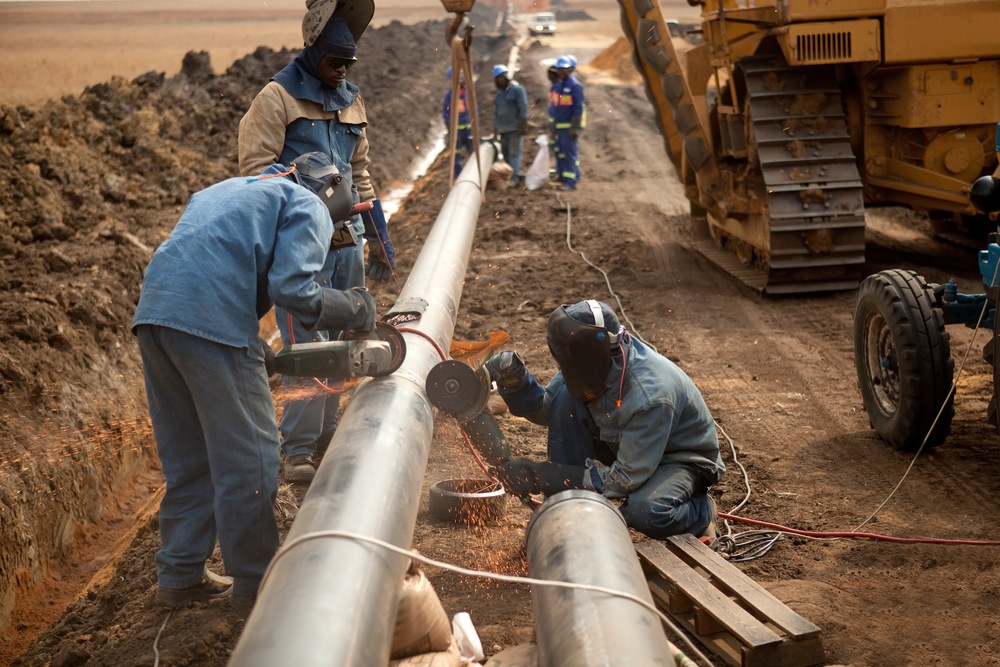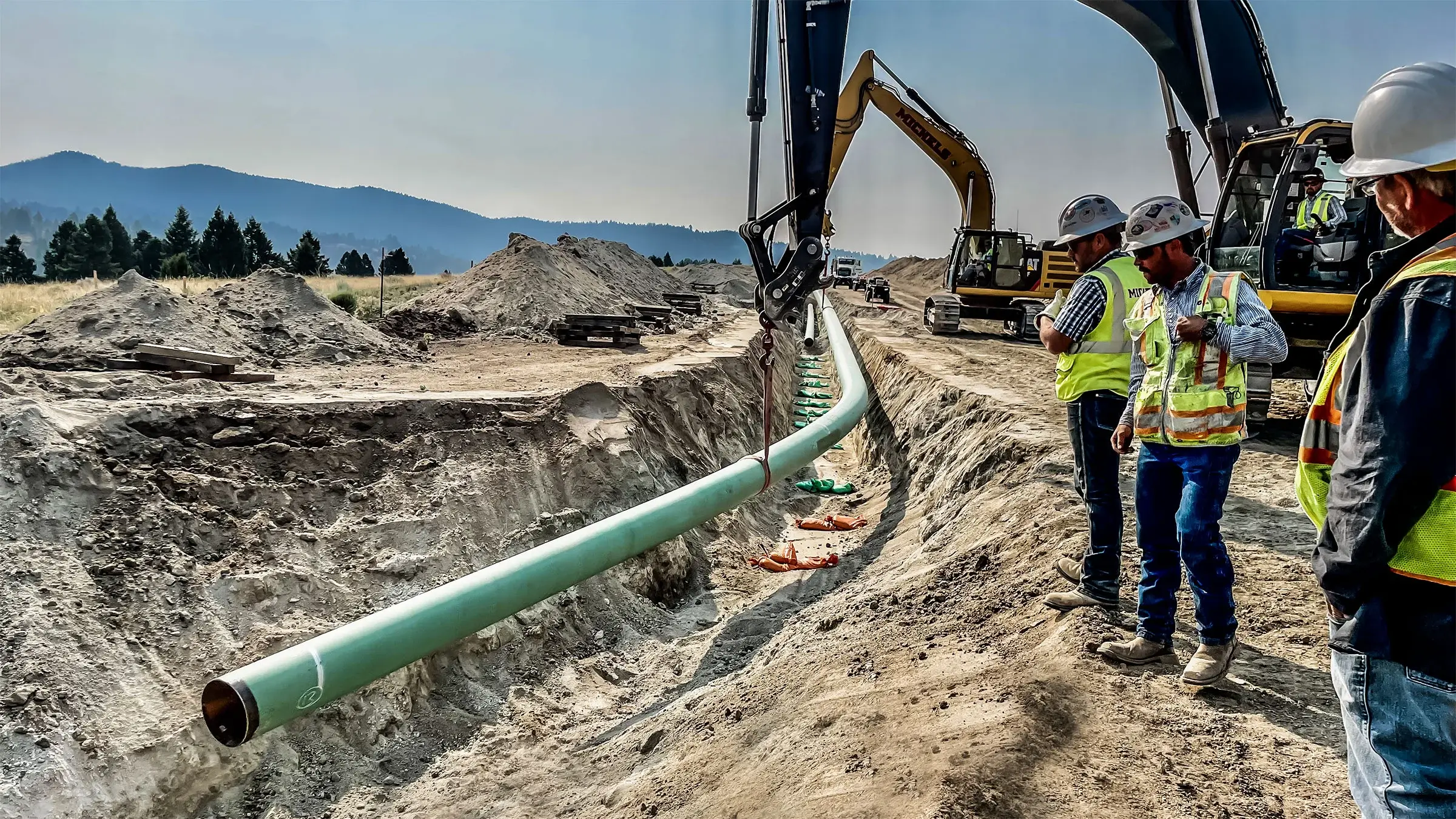Why Durable Systems Start With Proper Creek Pipe HDPE installation
The Value of Pipeline Construction: Checking Out the Services Offered in the Market
Pipeline construction is an important component of modern infrastructure. It assists in the transport of vital sources like oil, gas, and water. The industry includes numerous services, including preparation, website preparation, and installment. Each phase calls for precision and adherence to safety requirements. As communities rely on these systems for their resources, recognizing the complexities of pipe construction reveals its importance and possible difficulties. What variables affect the success of these projects?
Review of Pipeline Construction Solutions
Pipeline construction solutions encompass a variety of customized tasks designed to help with the setup of pipes for transferring various compounds, including oil, gas, and water. These services normally include site prep work, excavation, installment of pipe segments, and backfilling. Proficient labor and advanced devices are basic for ensuring each phase is implemented with precision and safety.Safety methods are extremely important, as these jobs usually include collaborating with hazardous products and in tough atmospheres. Quality control actions establish that the pipelines meet industry criteria and laws. Furthermore, the services may entail trenchless innovation, which reduces surface disruption.Environmental factors to consider play a significant duty in pipe construction, needing assessments and reductions to shield bordering ecological communities. On the whole, pipe construction services are crucial for establishing the facilities essential for power and water circulation, sustaining both economic growth and social requirements.
Planning and Design in Pipeline Projects
Reliable preparation and design are critical parts of effective pipeline tasks, guaranteeing that all aspects are diligently attended to before construction begins. This stage includes thorough expediency studies that examine the technical, financial, and ecological elements affecting the job. Designers and designers work together to create in-depth plans that lay out the pipeline course, products, and construction techniques, aligning with regulatory demands and market standards.Advanced software application and modeling techniques are often used to imitate different scenarios, enhancing the layout for performance and safety. Ecological influence assessments are conducted to mitigate potential injury to communities and communities, mirroring a dedication to sustainable methods. In addition, stakeholder interaction is necessary, cultivating communication and addressing concerns from influenced events. Inevitably, effective preparation and design set the structure for a pipeline project, lessening risks and making sure a structured construction procedure, inevitably adding to the total success of the procedure.
Website Prep Work and Excavation
Thorough site prep work and excavation are essential steps in the pipeline construction process. This phase involves a detailed assessment of the land where the pipe will certainly be mounted. Task groups carry out surveys to determine soil types, topography, and existing utility lines to guarantee a safe and efficient excavation. Proper website prep work minimizes environmental effect and assists in smoother construction operations.Excavation adheres to, where heavy machinery is employed to remove soil and rock, producing a trench that satisfies the defined deepness and size for the pipe. This procedure has to comply with safety regulations and ecological guidelines to protect against damages to surrounding ecosystems.Additionally, erosion control actions are carried out to stabilize the website throughout and after excavation. Effective website preparation and excavation contribute greatly to the total success of pipe jobs, laying a solid structure for the succeeding phases of construction.
Pipeline Installation Techniques
Pipeline installation strategies are crucial for the effective application of infrastructure tasks. 2 popular methods consist of trenchless modern technology, which decreases surface disturbance, and the open-cut excavation procedure, understood for its uncomplicated strategy. Each method supplies distinctive advantages and factors to consider relying on job requirements and ecological aspects.
Trenchless Technology Techniques
While traditional techniques of pipeline installment commonly include comprehensive excavation, trenchless modern technology techniques offer a much more efficient and eco-friendly alternative. These ingenious techniques, such as straight directional boring and pipe bursting, lessen surface disturbance by permitting the setup of pipes without extensive digging. This not only lowers the ecological impact however likewise greatly cuts down on labor and reconstruction costs. Trenchless methods help with the setup of pipes in urban areas where conventional excavation would certainly be impractical or harmful to existing facilities. In addition, these strategies can suit various soil types and conditions, making them flexible options for pipe construction. Ultimately, trenchless innovation stands for a substantial advancement in the pipe sector, promoting sustainability and operational efficiency.

Open-Cut Excavation Process
Open-cut excavation remains a fundamental technique in pipe installment, defined by the direct excavation of a trench to lay pipelines. This approach includes eliminating soil and various other products to create a trench of sufficient deepness and width, permitting the positioning of pipelines at the called for grade. Open-cut excavation is typically liked for its cost-effectiveness and simplicity, especially in areas with stable soil conditions. It can interrupt surface activities and needs cautious planning to manage traffic and ecological influences. Precaution have to be applied to shield employees and neighboring framework throughout the excavation procedure. In general, while open-cut excavation might not appropriate for all terrains, it stays a widely utilized approach in pipe construction.
Evaluating and Quality Control
Testing and high quality guarantee Full Article are essential elements in pipe construction, guaranteeing that installments meet well established safety and security standards and efficiency needs. Various assessment strategies and methods are utilized to analyze material high quality and adherence to governing conformity. This systematic method assists recognize potential problems prior to they rise, protecting the honesty of the pipe system.

Evaluation Techniques and Approaches
Evaluation techniques and approaches are crucial parts in guaranteeing the integrity and security of pipe construction. Different methods, including aesthetic evaluations, ultrasonic testing, and radiographic assessments, are utilized to spot flaws and confirm quality. Aesthetic assessments enable the recognition of surface abnormalities, while ultrasonic screening makes use of audio waves to assess wall thickness and locate flaws internally. Radiographic assessments include X-rays or gamma rays to generate pictures of the pipe's framework, disclosing covert problems. Furthermore, pressure screening is performed to review the pipe's integrity under operational problems. These approaches collectively contribute to a complete understanding of the pipeline's problem, enabling timely maintenance choices and making certain compliance with industry standards. Effective assessment is essential for avoiding failings and advertising lasting operational security.
Safety And Security Standards Compliance
Ensuring compliance with safety requirements is paramount in pipeline construction, as it directly impacts the project's general top quality and integrity. Complying with well established laws and standards assurances that construction techniques minimize threats related to pipeline installment and operation. Creek Pipe pipeline construction. Strenuous testing methods, including non-destructive testing and pressure assessments, are vital in verifying that pipes can endure the operational anxieties they will encounter. Quality control measures are likewise important, as they develop a framework for constant monitoring and examination throughout the construction process. By prioritizing safety and security requirements conformity, business not just secure workers and the atmosphere but likewise enhance the honesty of the pipeline, eventually leading to long-lasting functional success and public count on the facilities
Product High Quality Evaluation
Product quality analysis plays a considerable role in the overall honesty of pipeline construction. This procedure includes strenuous screening and quality control procedures to assure that materials meet market criteria and specifications. Various examinations, consisting of tensile toughness, corrosion resistance, and weld integrity evaluations, are performed to identify any type visit homepage of prospective weak points. A complete assessment not just guarantees the performance of the pipe but additionally enhances security and durability over its life expectancy. In addition, implementing quality assurance procedures helps alleviate threats connected with product failings, which can lead to expensive fixings and environmental threats. By prioritizing worldly top quality analysis, firms can assure conformity with governing requirements while fostering confidence amongst stakeholders in the integrity of their pipe systems.
Upkeep and Repair Services
Maintenance and repair services play an important role in the durability and effectiveness of pipeline systems. These services incorporate regular inspections, fixing, and restorative actions to address damage, leaks, and other concerns that might arise with time. Knowledgeable professionals use sophisticated technologies such as ultrasonic screening and wise pigging to monitor pipe integrity, ensuring that any kind of prospective problems are recognized early.Additionally, maintenance programs often consist of scheduled preventative actions created to enhance system integrity and lower the chance of unforeseen failures. Repair services may involve the substitute of broken sections, sealing leakages, or employing trenchless technology for marginal interruption.
Environmental Compliance and Precaution
Pipeline systems not only require recurring repair and maintenance other to work effectively yet also have to stick to rigid ecological compliance and safety and security measures. These policies are crucial for reducing environmental influence and guaranteeing public security. Firms in the pipeline construction industry carry out thorough environmental evaluations prior to task initiation, identifying prospective risks to wild animals and ecosystems.Furthermore, adherence to security methods safeguards employees and bordering communities. This consists of normal training on emergency action and spill prevention techniques.To preserve conformity, industries make use of checking modern technologies to find leaks and various other abnormalities in real-time. Environmental monitoring plans are often developed to lay out actions for attending to unforeseen problems throughout construction.Ultimately, rigorous adherence to ecological conformity and safety procedures not just satisfies legal obligations however likewise promotes lasting methods within the market, advertising an equilibrium in between framework growth and ecological stewardship.
Frequently Asked Questions
What Profession Opportunities Are Offered in Pipeline Construction?
Occupation chances in pipe construction incorporate functions such as job managers, designers, welders, and security inspectors. These placements need diverse abilities, offering pathways for development in an essential market of facilities development and power distribution.

Just How Do Pipeline Projects Effect Local Communities?
Pipeline jobs substantially influence local areas by influencing economic development, supplying task opportunities, and boosting framework. Nevertheless, they may additionally increase concerns regarding ecological impacts, land usage, and prospective disruptions to area cohesion and all-natural ecosystems.
What Technology Is Utilized in Modern Pipeline Construction?
Modern pipe construction utilizes sophisticated modern technologies such as GIS for mapping, drones for aerial surveys, and automated welding systems to boost efficiency, safety and security, and accuracy, eventually promoting the efficient transport of sources across different surfaces. Creek Pipe roustabout.
How Are Pipeline Construction Prices Estimated?
Pipeline construction costs are estimated with in-depth assessments of materials, labor, devices, and regulative demands. Variables like surface, task size, and environmental considerations also significantly influence the general budget plan and economic preparation for construction.
What Are the Largest Obstacles in Pipeline Construction Projects?
The largest obstacles in pipe construction jobs include regulative compliance, environmental issues, logistical problems, protecting funding, and managing labor shortages. Each factor can greatly impact timelines and budgets, complicating the overall implementation of the task.